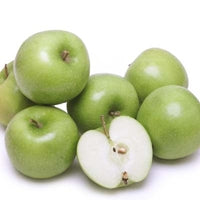How About Them Apples

We have all eaten Red Delicious apples and maybe even given them to our favorite third grade teacher as a gift.

But what do you really know about the apples you eat? Besides the fact that if they have the Melissa’s label on them you know they will be great? For example, did you know that apple varieties range in size from a little larger than a cherry to as large as a grapefruit? There are apples that have an aftertaste of pears, citrus, cinnamon, cloves, coconut, strawberries, grapes and even pineapple! Or what about information on specific varieties? Did you know that the Red Delicious is the number-one selling apple in the country, followed by Golden Delicious, Gala, Fuji and Granny Smith?
Or, that:
- They were first called a Hawkeye (probably since they were developed in Iowa) before Stark Brothers Nurseries purchased the rights and gave them their now well-known name.
- They have five distinct points on the bottom of each apple? Check it out next time you eat one.
Fuji
- Did you know that it is named after Mount Fuji (a mountain located southeast of Tokyo, Japan)?
- Or that Fuji apples are a combination of two varieties: Red Delicious and Ralls Janet. I was surprised at this since I’ve eaten many a Red Delicious apple, perhaps the Ralls are really something special.
- They have only been available in the United States since the 1980s.
- Although Fujis are good baked or frozen, due to their crisp texture and very sweet flavor, they are best suited for eating fresh or in salads.
- Because of this apple’s pretty pink color and because one of its parents was the Lady Williams apple it seems like an obvious name choice.
- Pink Lady® was developed in the 1970s by John Cripps in Western Australia, and is a cross between Golden Delicious and Lady Williams.
- Pink Lady® is a trademark; the actual variety name is Cripps Pink. To preserve the premium appeal of Pink Lady®, about 65 percent of the production that does not meet the required standards for Pink Lady® is sold as Cripps Pink instead. The distinction is primarily made on color intensity and the sugar/acid balance for which it is known.
- This was not first grown by a hobbit from Lord of the Rings.
- A green antique American apple, it is making a successful American comeback.
- This large, roundish apple has green skin and russet top that turns a greenish-yellow when fully ripe. Its white, aromatic flesh is tender and juicy.
- There are many varieties of Pippin; the two most widely recognized are Newtown Pippin or Cox Pippin.
- The Pippin is recognized for its excellent apple flavor and is considered one of the best dessert apples. They are also wonderful for fried apples on pancakes.
- Yes, there was a Granny Smith.
- Mary Ann (Granny) Smith developed the Granny Smith from a chance seedling found in her orchard.
- Granny Smith apples are great in salads because their tart flavor nicely complements sweeter vegetables and they keep their white color after being cut.
- A relatively new apple, and well worth tasting!
- The Cameo variety is a heart-shaped apple with a flavor that is sweet, yet tart; its crisp texture is complemented by its very thin skin.
- Cameo is a year-round crunchy variety.
- Cross of a Macoun Apple(a great pie apple) and Honeygold Apple from the University of Minnesota.
- Honeycrisp apples can be stored for three to four months in the refrigerator.
- Its flavor has been described thus, “The balance between sweet and tart utterly seduces your taste buds”.
- If you like Cortland, Empire, Macoun and Spartan apples, you should thank their parent, the McIntosh.
- This famous northeastern apple has white, tender, crisp flesh that’s uniquely spicy, highly aromatic and very juicy.
- They are great for applesauce.
- These are best eaten in the early part of the apple season, as they don’t store well for long periods.
I love coleslaw and I’m always trying it when I go out to dinner or at a gathering. There are so many different variations: sweet, sour, tart, chunky, fine, etc., each one unique as the person or place I’m visiting. Here’s a new one I tried from http://allrecipes.com.
Apple Coleslaw
Your basic coleslaw gets a sweet surprise with the addition of Granny Smith apples. This is great as a side dish with sandwiches, barbeque, or just about any of your late summer favorites.
4 cups shredded cabbage (I like to use red and green and even a bit of Napa for texture variation.)
1 cup shredded carrots,
1 Granny Smith apple, peeled, cored and coarsely shredded
2 tablespoons honey
1 tablespoon brown sugar
2 teaspoons white vinegar
1 tablespoon pineapple juice (optional)
2 tablespoons mayonnaise
1 dash salt
1 teaspoon ground black pepper
Place the shredded cabbage and carrot together in a bowl with the sliced apple, and toss to combine. In a separate bowl, stir together the honey, brown sugar, vinegar, pineapple juice and mayonnaise until the honey and sugar have dissolved completely. Pour over the salad and toss to coat. Season with salt and pepper and toss again. Cover and chill until ready to serve. Serves 6.
Recently I had a customer ask, “Can you tell me the best way to store my apples?” She told me that she leaves them in her fruit bowl but they don’t seem to hold up very long. Here’s the solution I gave her. Since apples ripen six to 10 times faster at room temperature than if they were refrigerated, I suggest you leave a couple in your bowl for quick eating and store the rest in the refrigerator to keep fresh, filling the bowl as needed. Enjoy this apple season and see if you look at your favorite Melissa’s apple the same as before.

